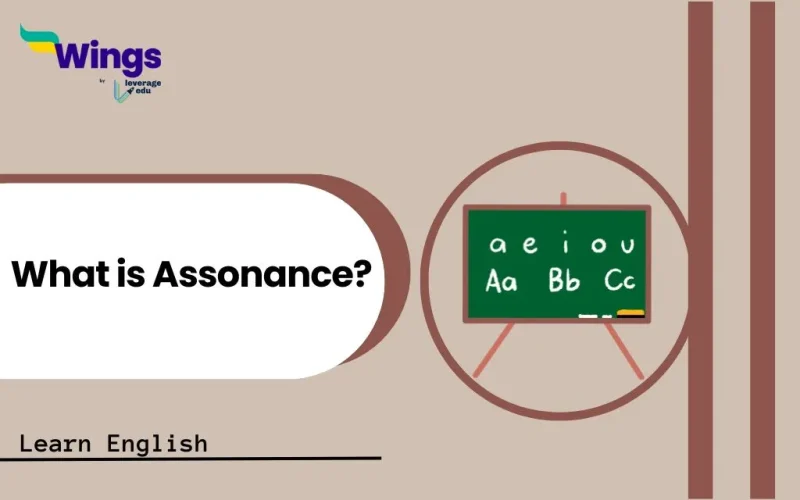Have you ever read a poem or a song lyric that seemed to flow beautifully, almost like music? One of the reasons behind this rhythmic beauty is a literary device called assonance. It might not be as well-known as rhyme or alliteration, but it plays a significant role in making language more expressive and engaging. In this article, we will explore what is assonance, how it works, and why it matters in writing.
This Blog Includes:
What is Assonance?
What is Assonance? It is the repetition of vowel sounds in nearby words within a sentence or a line of poetry. Unlike rhyme, which focuses on repeating sounds at the end of words, assonance occurs within words, creating a musical effect.
For example, in the sentence: “The rain in Spain stays mainly in the plain,”
The repeated “ai” sound in rain, Spain stays, and plain is an example of assonance.
Assonance is often used in poetry, prose, speeches, and even in everyday conversations to create a pleasing rhythm and emphasize certain words or emotions.
Also Read: Unseen Poems with Questions and Answers for Classes 1-10
Examples of Assonance
To better understand assonance, let’s look at some examples from literature, poetry, and popular culture:
1. Assonance in Poetry
Poets often use assonance to add a musical quality to their work. Here’s an example from Edgar Allan Poe’s poem The Bells:
“Hear the mellow wedding bells.”
The repetition of the “e” sound in mellow, wedding, and bells creates a melodious effect.
2. Assonance in Prose
Even in novels and stories, assonance can enhance the writing. Consider this sentence:
“The light of the fire is a sight to admire.”
The repeated long “i” sound in light, fire, sight, and admire makes the sentence more lyrical.
3. Assonance in Famous Speeches
Many great orators use assonance to make their speeches more powerful and memorable. Martin Luther King Jr.’s I Have a Dream speech includes assonance in lines like:
“We will be able to work together, to pray together, to struggle together.”
The repeated “uh” sound in together and struggle gives the speech a rhythmic quality.
4. Assonance in Songs and Rap Music
Musicians frequently use assonance to make their lyrics catchy. For instance, in Eminem’s song Lose Yourself, he uses assonance in the line:
“His palms are sweaty, knees weak, arms are heavy.”
The repetition of the “ee” sound in sweaty, knees, weak, and heavy enhances the flow of the lyrics.
Check out:
| Unseen Poem for Class 10 | Unseen Poem for Class 9 |
| Unseen Poem for Class 8 | Unseen Poem for Class 7 |
| Unseen Poem for Class 6 | Unseen Poem for Class 5 |
Why Writers Use Assonance?
Now that we know what assonance is, let’s explore why writers and speakers use it.
1. Creates Rhythm and Flow: Assonance gives sentences a musical quality, making them more enjoyable to read or hear. It helps maintain a smooth rhythm in poetry and prose.
2. Enhances Mood and Emotion: Depending on the vowel sound being repeated, assonance can create different moods. For example:
- The long “o” sound (e.g., cold, old, bold) can create a somber or serious mood.
- The short “i” sound (e.g., quick, still, win) can make the tone more energetic or playful.
3. Makes Phrases More Memorable: Because of the repetition, phrases with assonance tend to stick in our minds. This is why assonance is often found in slogans, speeches, and song lyrics.
4. Emphasizes Certain Words: By repeating vowel sounds, writers can draw attention to specific words, making them stand out more in a sentence.
Explore blogs on vowels here:
How to Use Assonance in Writing
If you want to use assonance effectively in your writing, here are some tips:
1. Choose a Vowel Sound That Matches Your Mood: Think about the tone you want to create. Do you want a soft, romantic feeling? Try repeating “oo” sounds (e.g., cool, moon, smooth). If you want a dramatic effect, use a strong “a” sound (e.g., fast, last, blast).
2. Don’t Overuse It: While assonance can enhance your writing, too much of it can make your sentences sound forced or unnatural. Use it in moderation.
3. Combine Assonance with Other Literary Devices: For the best effect, mix assonance with rhyme, alliteration (repetition of consonant sounds), and imagery to make your writing more vivid.
4. Read Your Writing Aloud: Since assonance is all about sound, reading your work aloud will help you identify whether it flows well or sounds awkward.
Assonance vs. Alliteration vs. Consonance
Assonance is often confused with alliteration and consonance, but they are different:
| Alliteration | Consonance | Assonance |
| The repetition of consonant sounds at the beginning of words. (Peter Piper picked a peck of pickled peppers.) | The repetition of consonant sounds within or at the end of words. (Mike likes his new bike.) | The repetition of vowel sounds within words. (The rain in Spain stays mainly in the plain.) |
Exercise on Assonance
Solve the questions in this section to test your understanding of this concept of English grammar.
Part 1: Identify the Assonance
Find the repeated vowel sound in each sentence.
- The cat sat on the mat.
Answer: The “a” sound in cat, sat, mat. - Mike tried to light the fire.
Answer: The long “i” sound in Mike, tried, light, fire. - Go and mow the lawn.
Answer: The long “o” sound in go, mow. - She sees the bees in the trees.”
Answer: The long “ee” sound in sees, bees, trees. - The old oak spoke softly.
Answer: The long “o” sound in old, oak, spoke. - The blue moon shone through the room.”
Answer: The long “oo” sound in blue, moon, through, room. - Jane made a great cake for the game.”
Answer: The long “a” sound in Jane, made, great, cake, game. - The wind whistled in the winter chill.”
Answer: The short “i” sound in wind, whistled, winter, chill. - He left his best friend to rest.”
Answer: The short “e” sound in left, best, friend, rest. - I might fly high in the bright sky.”
Answer: The long “i” sound in might, fly, high, bright, sky.
Part 2: Fill in the Blanks with Assonance
Complete the sentence using a word that creates assonance with the given words.
- The bright ____ in the night sky.” (Choose a word with the long “i” sound, like “light” or “kite”)
Answer: light/kite - “The cool wind blew past the ____.” (Choose a word with the “oo” sound, like “pool” or “school”)
Answer: Pool/school - “The bells rang in the ____ evening.” (Choose a word with the short “e” sound, like “red” or “wet”)
Answer: red/wet - “The brave knight held his shining ____.” (Choose a word with the long “i” sound, like “sword” or “light”)
Answer: light/sword
- The small boat slowly began to ____.” (Choose a word with the long “o” sound, like “float” or “row”)
Answer: float/row
- The green leaves sway in the gentle ____.” (Choose a word with the long “ee” sound, like “breeze” or “trees”)
Answer: breeze/trees
- The sad man sat with his head in his ____.” (Choose a word with the short “a” sound, like “hands” or “lap”)
Answer: hands/lap
- The cold snow covered the lonely ____.” (Choose a word with the long “o” sound, like “road” or “stone”)
Answer: road/stone
- A fast car dashed past the ____.” (Choose a word with the short “a” sound, like “track” or “path”)
Answer: track/path
- The deep sea hides many mysteries in its ____.” (Choose a word with the long “ee” sound, like “sleep” or “deep”)
Answer: deep/sleep
Check other blogs on Learn English below:
| Best Websites to Learn English | How to Learn English Speaking at Home? |
| Learning English as a Second Language (ESL) | Games To Learn English |
| Pros and Cons of Learning English Online | English Speaking Exercises |
FAQs
It is the repetition of vowel sounds in nearby words within a sentence or phrase. It creates a musical or rhythmic effect in poetry, speeches, and songs.
Rhyme focuses on repeating sounds at the end of words (like cat, hat, mat), while assonance repeats vowel sounds within words (like light, fire, time).
Yes! Phrases like “Go slow on the road” or “The early bird catches the worm” use assonance naturally in conversation.
Writers use it to create rhythm, enhance mood, and make phrases more memorable in poetry, prose, and songs.
No, assonance appears in all forms of writing, including speeches, advertisements, song lyrics, and storytelling to make language more engaging.
We hope this blog helped you improve your English skills. You can also follow the Learn English page of Leverage Edu for more exciting and informative blogs related to English grammar and the English language.
 One app for all your study abroad needs
One app for all your study abroad needs















 60,000+ students trusted us with their dreams. Take the first step today!
60,000+ students trusted us with their dreams. Take the first step today!

